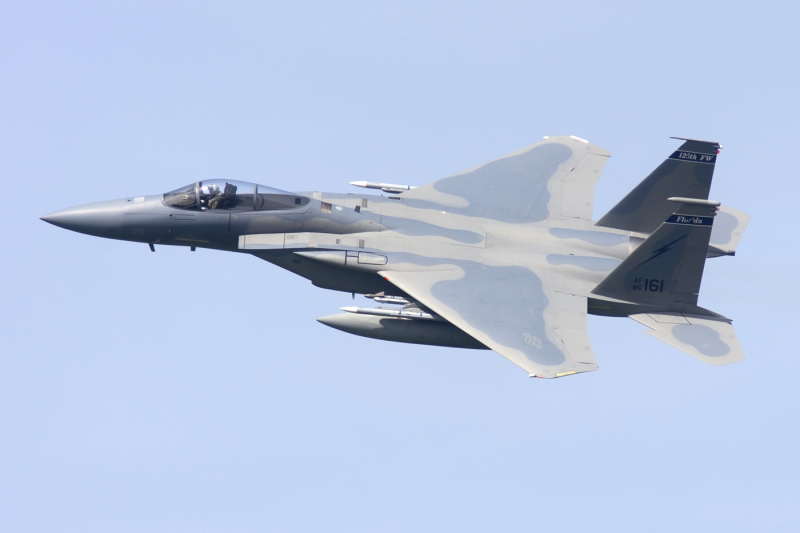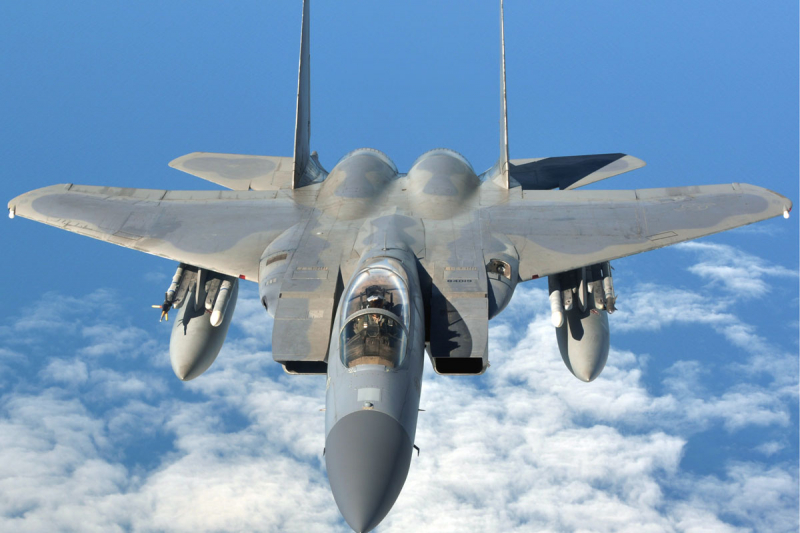McDonnell Douglas F-15 Eagle

The F-15 Eagle is an all-weather, extremely maneuverable tactical fighter designed to give the Air Force air superiority over the battlefield.
The Eagle achieves air superiority through a combination of unprecedented maneuverability and acceleration, range, weapons, and avionics. It is capable of breaching enemy defenses and outperforming and outfighting any current enemy aircraft. The F-15 has electronic systems and weaponry that allow it to detect, acquire, track, and attack enemy aircraft while flying in friendly or enemy airspace. The weapons and flight control systems are designed so that air-to-air combat can be performed safely and effectively by a single person.
The F-15's excellent acceleration and maneuverability are made possible by its low wing loading and high engine thrust-to-weight ratio. A crucial component of maneuverability is low wing loading, which, when combined with a high thrust-to-weight ratio, allows an aircraft to turn quickly without losing speed.
The F-15 differs from other fighter aircraft thanks to its multi-mission avionics system. Advanced radar, inertial navigation, flying instruments, ultrahigh frequency communications, a tactical navigation system, and an instrument landing system are all included. It also has a head-up display. Additionally, it has a tactical electronic warfare system mounted internally, a "identifying friend or foe" system, a set of electronic countermeasures, and a main digital computer.
The integrated avionics system projects all critical flight information onto the pilot's windscreen via the head-up display. This display, which is visible in all lighting conditions, provides the information required to track and destroy an enemy aircraft without having to look down at cockpit instruments.
The F-15's adaptable pulse-Doppler radar system can scan low- and high-flying targets without being distracted by background noise. In close proximity and at altitudes as low as treetop level, it is capable of detecting and tracking small, high-speed objects and aircraft at distances beyond optical range. The central computer receives target data from the radar for efficient weapon delivery. The head-up display displays adversary aircraft that are automatically acquired by the radar during close-range dogfights. The electronic warfare system of the F-15 offers automatic countermeasures and threat warnings for specific threats.
Technical Notes
Power plant: Two Pratt & Whitney F100-PW-100, 220 or 229 turbofan engines with afterburners
Thrust: (C/D models) 23,450 pounds each engine
Wingspan: 42.8 feet (13 meters)
Length: 63.8 feet (19.44 meters)
Height: 18.5 feet (5.6 meters)
Weight: 31,700 pounds
Ceiling: 65,000 feet (19,812 meters)
Range: 3,450 miles (3,000 nautical miles) ferry range with conformal fuel tanks and three external fuel tanks
Crew: F-15A/C, one; F-15B/D/E, two
Armament: One internally mounted M-61A1 20-mm, six-barrel cannon with 940 rounds of ammunition; four AIM-9 Sidewinder and four AIM-120 AMRAAMs or eight AIM-120 AMRAAMs, carried externally.
Maximum speed: 1,875 mph (Mach 2 class)











